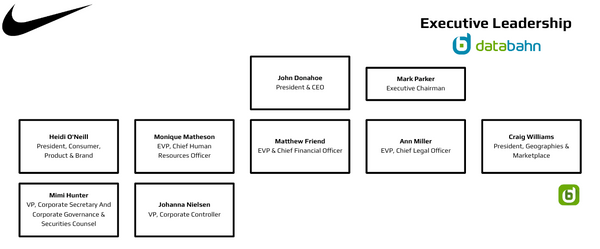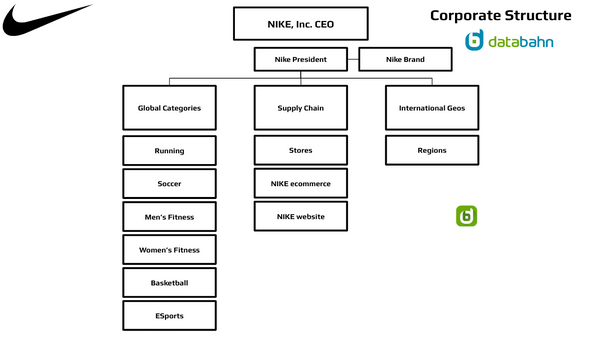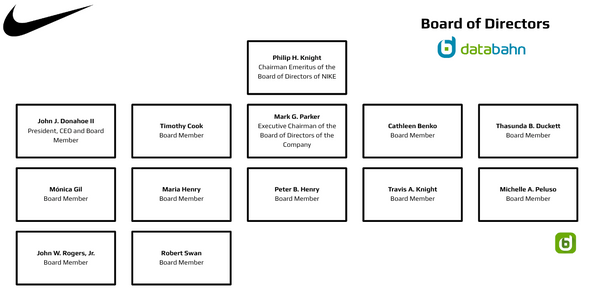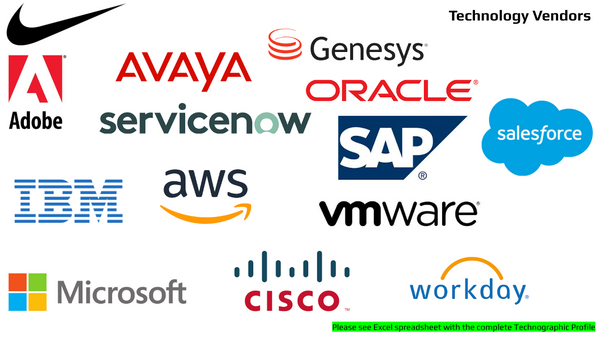Nike Org Chart & Sales Intelligence Blog: Nike Key Insights & Overview
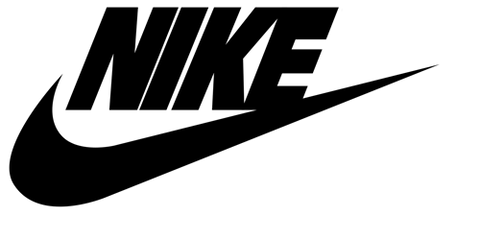
March 12, 2024
Download the Nike Org Chart & Sales Intelligence Report
NIKE, Inc.
One Bowerman Drive
Beaverton, OR 97005-6453
United States
Main Phone: (503) 671-6453
Website: https://www.nike.com
Sector(s): Consumer Cyclical
Industry: Footwear & Accessories
Full Time Employees: 83,700
Annual Revenues: $51.54 Billion USD
Fiscal Year End: May 31, 2024
Fortune 500 Rank: #93 in 2023
CEO: John J. Donahoe II, President, CEO & Director
What is the Nike Mission Statement and Business Philosophy?
Nike's mission statement is:
"To bring inspiration and innovation to every athlete in the world." (The asterisk clarifies with Bill Bowerman's quote: "If you have a body, you are an athlete."")
This statement emphasizes three key aspects:
- Inspiration: Nike aims to motivate people to pursue their athletic goals and embrace the power of movement.
- Innovation: The company is committed to developing cutting-edge products and technologies that enhance athletic performance.
- Inclusivity: Nike defines "athlete" broadly to encompass everyone with a body, regardless of skill level.
Beyond the mission statement, Nike's business philosophy is guided by several core principles:
- Focus on the Athlete: Everything Nike does centers around understanding and meeting the needs of athletes at all levels.
- Innovation: Continuous development of new technologies and designs is a core tenet of Nike's approach.
- Sustainability: The company strives to minimize its environmental impact and operate responsibly.
- Community: Nike is committed to giving back to the communities where it operates and supporting social causes.
These principles are often referred to as Nike's "11 Maxims" and serve as a guiding light for employee decision-making. Essentially, Nike aims to be a company that inspires and empowers people to achieve their athletic potential through innovation, while remaining a responsible and sustainable global citizen.
Who is the current CEO of Nike?

John Donahoe is an American businessman currently serving as the President and CEO of Nike since January 2020. He brings a wealth of experience in leading global companies across various sectors.
Experience
- CEO of Nike (2020 - Present): Leading Nike's global business portfolio, including the Jordan Brand and Converse, and driving continued growth.
- Chairman of PayPal (Current): Overseeing the online payments platform.
- CEO of ServiceNow (2017 - 2020): Successfully led the cloud computing company.
- CEO of eBay (2008 - 2015): Expanded eBay's reach through strategic acquisitions.
- Bain & Company (Early Career): Extensive experience in consulting, culminating in becoming the firm's CEO in 1999.
Skills and strengths
- Strategic Leadership: Proven ability to lead and grow large, complex organizations.
- Digital Transformation: Experience in leveraging technology to drive business success.
- Brand Building: Understanding of brand strategy and customer engagement.
- Global Business Acumen: Experience operating in international markets.
- Served on the Board of Directors at Nike since 2014 before becoming CEO.
- Previously held leadership positions at The Bridgespan Group and Dartmouth College.
John Donahoe's diverse background and proven leadership skills make him a strong leader for Nike as they navigate the competitive athletic apparel and footwear industry.
Who is on the Nike Executive Leadership team in 2024?
- John Donahoe, President & CEO, Nike, Inc.
- Matthew Friend, EVP & Chief Financial Officer, Nike, Inc.
- Monique Matheson, EVP, Chief Human Resources Officer, Nike, Inc.
- Ann Miller, EVP, Chief Legal Officer, Nike, Inc.
- Mark Parker, Executive Chairman, Nike, Inc.
- Heidi O'Neill, President, Consumer, Product & Brand, Nike, Inc.
- Craig Williams, President, Geographies & Marketplace, Nike, Inc.
- Johanna Nielsen, VP, Corporate Controller, Nike, Inc.
- Mimi Hunter, VP, Corporate Secretary And Corporate Governance & Securities Counsel, Nike, Inc.
Nike Org Chart - Corporate Structure
What are Nike’s growth strategies for 2024 and beyond?
Databahn research analysts expect Nike to focus on several key growth strategies for 2024 and beyond:
- Direct-to-Consumer (DTC) Acceleration: Nike has been prioritizing its own e-commerce channels and physical stores (Nike Direct) to connect directly with consumers. This allows for better control over brand messaging, customer experience, and potentially higher margins. They likely will continue expanding their DTC footprint while strategically collaborating with wholesale partners.
- Digital Innovation: Investment in digital tools and experiences is crucial. This could involve areas like:
- Enhanced e-commerce platforms: Offering a seamless online shopping experience with features like personalization and recommendation engines.
- Mobile app development: Engaging with customers through their mobile devices for purchases, loyalty programs, and exclusive content.
- Data analytics: Utilizing data to understand customer preferences and tailor marketing efforts for maximum impact.
- Global Market Expansion: Nike will likely continue to focus on emerging markets with high growth potential, particularly in Asia. This might involve strategic partnerships or targeted marketing campaigns to expand brand awareness and market share.
- Product Innovation: Maintaining a steady stream of innovative products with cutting-edge technologies and sustainable materials is essential. This caters to the evolving needs of athletes and environmentally conscious consumers.
- Focus on Women's and Kids' Apparel: These are growing segments within the athleticwear industry, and Nike is likely to dedicate resources towards developing products and marketing campaigns specifically targeted at these demographics.
- Sustainability: Consumers are increasingly concerned about environmental responsibility. Nike is expected to continue implementing sustainable practices throughout their supply chain and product lifecycle.
By focusing on these strategies, Nike aims to solidify its position as a leading innovator in the athletic apparel and footwear industry, while remaining relevant to a global and environmentally conscious customer base.
Who are Nike’s top competitors in the marketplace?
Nike faces competition from several major players in the athletic apparel and footwear market. Here are some of their top competitors:
- Adidas: The German multinational is Nike's biggest competitor, with a strong global presence and a similar range of products across footwear, apparel, and accessories.
- Puma: A smaller but growing competitor, Puma offers a more affordable alternative to Nike and Adidas, and has gained traction in recent years with innovative technologies and celebrity endorsements.
- Under Armour: An American brand focusing on performance apparel and footwear, particularly popular in the United States.
- VF Corporation: This parent company owns several athletic and outdoor apparel brands like The North Face, Vans, and Timberland, competing with Nike in specific segments.
- Lululemon Athletica: While primarily known for yoga apparel, Lululemon has expanded into general athleticwear and competes with Nike for the women's fitness market.
Beyond these major players, Nike also faces competition from:
- New Balance: A brand known for its focus on comfort and offering a wider range of shoe widths.
- Skechers: An American company offering a more casual and lifestyle-oriented athletic footwear option.
- Asian Brands: Li Ning and Anta are Chinese athleticwear brands gaining popularity domestically and pose a growing threat in the Asian market.
The specific competitive landscape can vary depending on the product category and geographic location. However, Nike's main battlegrounds are with established giants like Adidas and Puma, while also keeping an eye on emerging brands and niche players.
Who was elected to Nike’s Board of Directors in 2024?
- Philip H. Knight, Chairman Emeritus of the Board of Directors of NIKE, NIKE, Inc.
- Mark G. Parker, Executive Chairman of the Board of Directors of the Company, NIKE, Inc.
- John J. Donahoe II, President and Chief Executive Officer, NIKE, Inc.
- Cathleen Benko, Board Member, NIKE, Inc.
- Timothy Cook, Board Member, NIKE, Inc.
- Thasunda B. Duckett, Board Member, NIKE, Inc.
- Mónica Gil, Board Member, NIKE, Inc.
- Maria Henry, Board Member, NIKE, Inc.
- Peter B. Henry, Board Member, NIKE, Inc.
- Travis A. Knight, Board Member, NIKE, Inc.
- Michelle A. Peluso, Board Member, NIKE, Inc.
- John W. Rogers, Jr., Board Member, NIKE, Inc.
- Robert Swan, Board Member, NIKE, Inc.
What Technology Platforms have been deployed across Nike?
Here are some of the technology platforms Nike has likely deployed across its operations:
E-commerce and Direct-to-Consumer (DTC) Channel:
- E-commerce platform: Nike has its own robust e-commerce platform for online sales, offering features like product browsing, shopping carts, secure payment gateways, and order tracking.
- Customer Relationship Management (CRM) system: This helps manage customer data, personalize marketing campaigns, and track customer interactions across touchpoints.
- Warehouse Management System (WMS): Optimizes inventory management within Nike's distribution centers, ensuring efficient order fulfillment for online and physical stores.
Mobile App:
- A mobile app exists to enhance the customer experience. It includes features like:
- Product browsing and purchasing capabilities.
- Personalized product recommendations based on past purchases or browsing behavior.
- Membership and loyalty program management.
- Content feeds with workout tips, athlete stories, or exclusive product launches.
Supply Chain Management:
- Enterprise Resource Planning (ERP) system: This integrates various business functions like finance, inventory, and production, providing a holistic view of Nike's operations.
- Supply Chain Management (SCM) software: Tracks the movement of materials and finished goods throughout the supply chain, optimizing logistics and ensuring on-time deliveries.
Product Design and Development:
- Computer-aided design (CAD) software: This allows for 3D modeling and design of footwear and apparel, facilitating the design process and prototyping.
- Product Lifecycle Management (PLM) system: Manages the entire lifecycle of a product, from design and development to manufacturing and end-of-life.
Data Analytics and Marketing:
- Business intelligence (BI) tools: Used to analyze customer data, sales trends, and market performance to gain insights and inform decision-making.
- Marketing automation platforms: Automate marketing tasks like email campaigns, social media marketing, and targeted advertising based on customer data.
Other Platforms:
- Cloud computing platforms: Nike leverages cloud services from providers like Amazon Web Services (AWS) and Microsoft Azure for scalability, data storage, and running some of their applications.
- Artificial intelligence (AI): AI is used in various areas like product recommendations, personalized marketing, or chatbot customer service.
It's important to note that this is not an exhaustive list, and the specific technology platforms Nike utilizes can be referenced in the Nike Technographic Profile.
Nike SWOT Analysis

Strengths, Weaknesses, Opportunities, and Threats Analysis of Nike, Inc.
STRENGTHS
- Strong Brand Equity: Nike boasts a powerful and globally recognized brand synonymous with athletic performance, innovation, and inspiration.
- Market Leader: Nike holds a dominant position in the athletic apparel and footwear market, with a significant market share and brand loyalty.
- Diversified Product Portfolio: The company offers a wide range of footwear, apparel, and equipment catering to various sports and activities.
- Direct-to-Consumer (DTC) Focus: Nike is increasingly prioritizing its own e-commerce channels and physical stores, allowing for greater control over brand messaging and potentially higher margins.
- Innovation: Nike has a strong history of developing cutting-edge technologies and designs for their products.
- Effective Marketing: Nike leverages impactful marketing campaigns featuring star athletes and inspiring narratives to connect with consumers.
WEAKNESSES
- Reliance on Manufacturing Outsourcing: Nike heavily relies on overseas factories for production, which can be susceptible to labor issues, quality control problems, and supply chain disruptions.
- High Pricing: Nike products are often priced at a premium compared to competitors, which may limit accessibility for some consumers.
- Controversies: Nike has faced criticism regarding labor practices in its supply chain and environmental impact. These controversies can damage brand reputation.
- Dependence on Wholesale Partners: While Nike is growing its DTC presence, they still rely on wholesale partners for a significant portion of sales. This can limit control over brand image and pricing strategies.
OPPORTUNITIES
- Global Market Expansion: The athletic apparel market is growing in emerging markets, particularly in Asia. Nike can capitalize on this by expanding its presence in these regions.
- E-commerce Growth: The continued growth of e-commerce presents an opportunity for Nike to further expand its online sales channels and reach a wider audience.
- Digital Innovation: Leveraging technology for areas like mobile apps, personalized marketing, and data analytics can enhance customer experience and drive sales.
- Sustainable Practices: Consumers are increasingly concerned about environmental responsibility. Implementing sustainable practices throughout the supply chain can attract environmentally conscious customers and improve brand image.
- Focus on Women's and Kids' Apparel: These are growing segments within the athleticwear industry, and Nike can capitalize by developing targeted products and marketing campaigns.
Threats
- Competition: The athletic apparel market is highly competitive, with established players like Adidas and Puma constantly innovating and vying for market share. Emerging brands and new technologies also pose threats.
- Economic Downturns: Economic recessions can lead to decreased consumer spending on discretionary items like athletic apparel, impacting Nike's sales.
- Shifting Consumer Preferences: Changes in consumer preferences towards athleisure or other fashion trends could affect demand for traditional athletic wear.
- Trade Regulations: Changes in trade regulations or tariffs could disrupt Nike's global supply chain and increase production costs.
Download the Nike Org Chart & Sales Intelligence Report
About databahn
Founded in 2015, databahn is an account intelligence company headquartered in Nashua, NH. The databahn research team specialize in providing comprehensive and up-to-date company profiles on Fortune 1000 and Global 2000 companies. databahn offers a range of information services, including deep dive company profiles, financial insights, news updates, competitive analysis, and accurate contact information. databahn's account intelligence is meticulously curated, enabling businesses to make informed decisions, identify sales opportunities, and gain a competitive edge. With the focus on accuracy, completeness, and timeliness, databahn serves as a valuable resource for sales and marketing professionals and other industries that require reliable and actionable insights on large & complex enterprise companies.

